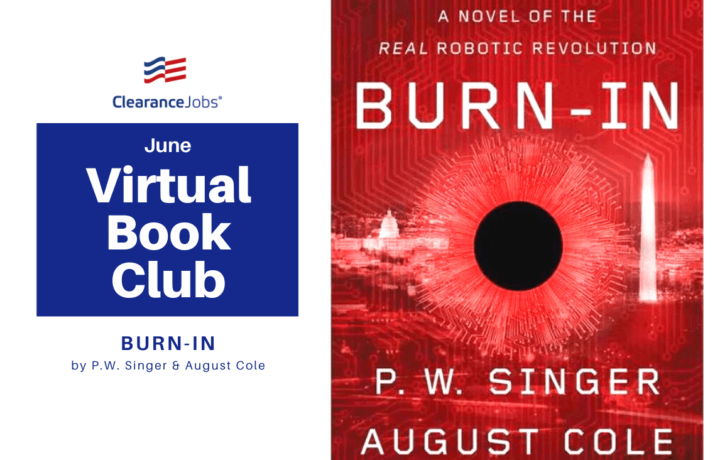“Reading is essential for those who seek to rise above the ordinary.” – Jim Rohn
From the way we work to the way we fight wars, the growth of artificial intelligence and robotics have the potential to change everything. What used to look like science fiction is now the reality. But do we need to fear the robotic revolution? It seems almost every topic is dangerously polarizing today – including technology. Some see it as progress and opportunity. Others are concerned about how the rules of engagement could change with AI in our law enforcement and military operations.
Burn-In: A Novel of the Real Robotic Revolution takes real-world research and turns it into plausible fiction. It’s also the next selection in the ClearanceJobs Book Club. Why read a book that turns emerging technological advacements into science fiction? Besides the fact that it’s entertaining, it’s also a believable (and therefore, education) foray into today’s national security challenges. Anyone interested in military planning and strategy knows that preparing for future threats is based on a lot of healthy speculation. Enter the world of P.W. Singer and August Cole’s fictional terrorist threats in Burn-In.
Interested in reading with us? We’ll send copies of Burn-In to the first 10 people to request a book – just email lindy.kyzer@clearancejobs.com with your mailing address!
It’s not the duo’s first novel exploring the intersection of future war and technology. They describe prior novel, Ghost Fleet: A Novel of the Next World War, as “a book that wouldn’t just peer into the potential future, but immerse readers in it.”
Burn-In looks at how AI is – and could – potentially change our lives. It envisions a future FBI human-robotics partnership, and all of the relational and ethical challenges that go into a world where AI isn’t just speculation, but a part of the counterterrorism solution.
Some agencies, like the Combating Terrorism Technical Support Office (CTTSO), are already pairing NASA’s robotics with current counterterrorism threats.
Dr. Joshua Mehling, Technical Discipline Lead for Robotic Control at NASA’s JSC said “Humanoid robots have the potential to drastically change the way we perform remote operations, because by their very nature, they are designed to interact with the same tools, and interfaces that humans do, move through the same spaces, and work in the same environments. CTTSO immediately saw the impact that NASA’s humanoid technology could have in the EOD space. Human-like robotic hands are a game-changer for interacting with the world, not only manipulating common objects and potential threats, but the robot can easily leverage existing EOD tools and equipment designed for the bomb technician…Our initial work with CTTSO is really just the beginning. As we continue to push this technology forward out into the field, and into the hands of bomb techs, we will begin to realize enormous operational benefits, and that’s how we’ll address the challenges and mitigate the threats of today and tomorrow.”
Just further evidence of how the fiction chronicled in Burn-In today could be the nonfiction of tomorrow. Singer and Cole are reading the tea leaves of military technology – join ClearanceJobs this month as we go along for the ride (And check out Valkyrie in Action while you read your copy of Burn-In).




